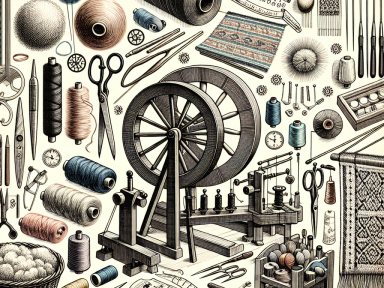Making Your Own Clothing and Textiles: A Guide to Self-Sufficiency
There’s a growing realization among many people that self-reliance is critical in tumultuous times. One often overlooked area is the ability to create and repair your own clothing and textiles. This knowledge can set you apart when resources become scarce and provide the means to survive when the world as we know it changes dramatically.
The importance of knowing how to make your own clothing and textiles
Our ancestors did not have the luxury of running to a department store at the first sign of wear on their garments. Instead, they relied on their hands and minds to repair and create when necessary. In times of scarcity or unavailability of resources, these skills can mean the difference between comfort and misery, dignity and despair.
Gathering your tools and materials
The first step in creating clothing and textiles is to gather your necessary tools. This will include items such as:
- Spinning wheels or drop spindles
- Looms
- Sewing needles
- Scissors
- Measuring tools
Harvesting and preparing your materials
Choosing the right materials is essential. Wool, cotton, flax, and even certain types of tree bark can be transformed into practical, wearable textiles. Knowing how to grow, harvest and prepare these materials yourself further expands your skills and makes you less dependent on the outside world.
Wool:
For those with access to sheep, Wool provides an excellent source of warm, durable material. Collecting the fleece involves shearing the sheep, cleaning the wool and then carding it to align the fibers.
Cotton:
Cotton plants, when cared for properly, can yield a fair amount of usable material. Once the cotton bolls are opened, they are harvested and the seeds removed. The cotton is then carded like wool.
The process of making your own textiles
The process of creating your own textiles can be a time-consuming one, requiring patience and expertise. However, the satisfaction that comes from wearing your own handmade garments is incomparable.
- Spinning transforms the prepared material into yarn or thread.
- Weaving or knitting this yarn or thread turns it into fabric.
- This fabric is then cut and sewn into the desired garment using a pattern or one’s own design.
Darning and mending
Knowing how to mend and darn your garments is equally important as like creating them. Clothes wear out, but knowing the right techniques can give them a new lease on life and save valuable resources.
Whether society collapses, resources become scarce, or you simply wish to become more self-reliant, learning to create and repair your own textiles is a skill that can have profound and enduring benefits. The ability to produce your own clothing is a life skill that goes beyond simple self-sufficiency — it becomes a means of empowerment and survival. Remember, our ancestors did not have the luxury of dependency; they had to be self-reliant. It’s time we reclaim those abilities.




GIPHY App Key not set. Please check settings